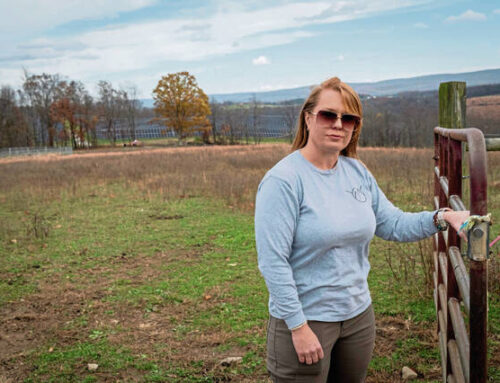Here’s what Breckenridge is doing to move toward its renewable energy goals
May 26, 2025
The town of Breckenridge is 10 years out from its target date to have 100% renewable electricity used community-wide, and it is currently formulating initiatives to get residential real estate in line with that goal.
It is working on a similar timeline as Summit County — which adopted a nearly identical initiative for its unincorporated areas — and joins other mountain towns like Frisco and Park City in working toward community-wide electrification.
Worries regarding Xcel Energy reaching its limit to supply natural gas is fueling the town’s efforts for moving to renewable electricity. As the town building staff works on revamping the energy code that new builds, and in some cases renovations, must be in line with, elected officials look at making another town policy more stringent.
Every six years, Breckenridge and Summit County must update their building energy codes, and the planning process started in spring 2025 with stakeholder outreach. Breckenridge’s chief building officer Rick Fout said building energy codes can help the town reach its sustainability goals by keeping both residential and commercial buildings high performing and efficient.
This code adoption cycle, the town acquired a $125,000 grant from the Colorado Energy Office that sets a hard implementation deadline for the codes on Oct. 28. The grant came with the opportunity to hire an advisor, and the town picked expert Shaunna Mozingo, who has won national awards for advancing energy codes.
Coming out of the first roundtable discussion in late March where the town’s proposed changes were unveiled, builders and contractors said what was currently on the table, for the most part, would help streamline aspects of adhering to the code for them. The town is looking to make local modifications to the 2024 International Energy Conservation Code while using the international code as a baseline. The international code is largely in line with what the town wants to accomplish with its code.
Builders seemed to share the same sentiment at the second roundtable on April 17, with no one protesting what the town building staff suggested in terms of creating different pathways for builders to follow the code. Fout and Mozingo explained the town was looking at bringing over core portions from codes that the builders are used to, like the Summit Sustainable Building Code, so the transition feels more seamless.
An example of pertinent building codes subject to change are those regarding insulation in ceilings, walls and floors, Fout said. The International Energy Conservation Code the town is looking to adopt also sets some penalties for fuel burning appliances in new builds with energy usage that exceeds a certain threshold. In an explanatory document included in the meeting’s presentation, Mozingo noted jurisdictions like Breckenridge cannot make mandates like this written in the international code it plans to adopt less restrive.
One change on the table that concerned builders at the last two meetings was a requirement to construct homes to be “energy ready” by equipping them with the infrastructure to be all-electric. Mike Costello with New West Partners Builders and Developers said he felt this would be costly for builders. He also has expressed that there doesn’t seem to be proven technology for homes at 10,000 feet of elevation. He wanted more clarification on how that was going to work at the April 17 meeting.
“I’d love to hear more about technology and heat pumps and see how we’re going to heat homes in (our high-elevation environment),” he said. “It doesn’t make sense to me.”
Mozingo replied that “it works,” but acknowledged an expert would likely have to be brought in to help the town figure out a plan for that and “there’s probably going to (need to) be some auxiliary backup heat forms.”
She said the technology is starting to get there and “it’s not as big of an issue as you think it is.”
During her presentation, Mozingo touched on how energy code requirements could vary for home size, which is a concept elected officials have been looking at for certain neighborhoods in town as a part of their own sustainability initiative. An uptick in scrapes — when smaller homes are demolished to build larger ones— became a growing concern of Breckenridge Town Council in 2024. The town wanted to limited the size of homes being built in the town’s most established neighborhoods where a majority of these scraps where happening and create requirement around new homes energy usage.
During discussions around energy used during building, Breckenridge officials reviewed stats taken from a 2023 report out of Pitkin County. Pitkin County officials conducted the study following the adoption of regulations that placed limits on maximum home sizes. The report demonstrated “a strong correlation between home size and greenhouse gas emissions per area.” It found that as home size increased from 1,000 square feet to 14,000 square feet, which was the size of the largest homes considered in the study, greenhouse gas emissions more than doubled. Also, it demonstrated the maintenance of large homes in unincorporated Pitkin County generated nearly 9% of the county’s total 2019 annual greenhouse gas emissions.
Staff members also noted “a more imminent concern related to Xcel (Energy) reaching its limit to supply natural gas and the need to shift more properties to use electricity exclusively for energy” during the November discussion.
Stats taken from the 2023 Pitkin County report that demonstrated “a strong correlation between home size and greenhouse gas emissions per area” were particularly concerning to council and help drive their push to refresh their Neighborhood Preservation Policy geared at maintaining “community character.”
Work on both policies continues and no final decisions have been made.
Search
RECENT PRESS RELEASES
Related Post




